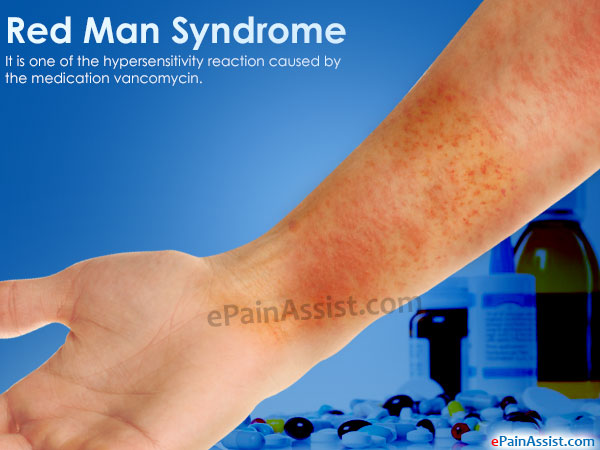What is Red Man Syndrome?
Red man syndrome is one of the hypersensitivity reaction caused by the medication vancomycin. Other reaction of this medicine is anaphylaxis. Red man syndrome (RMS), also known as “red neck syndrome” is the most commonly occurring negative reaction to the medicine vancomycin.
Majority of the cases will have resolution of the reaction, i.e. red man syndrome, as soon as the infusion of vancomycin is stopped and diphenhydramine is taken to halt the reaction. Slow intravenous administration of vancomycin is the best method to prevent and cut down the risk of adverse effects of vancomycin infusion.

Causes of Red Man Syndrome
- As mentioned above, the cause of Red Man Syndrome is a hypersensitive reaction occurring as a result of vancomycin infusion.
- Patient can develop this reaction, i.e., red man syndrome irrespective of the route of the vancomycin i.e. whether it is taken intraperitoneally (via an injection) or orally.
- Red Man Syndrome can also occur as a reaction to other medicines, such as antibiotics including rifampicin, teicoplanin, ciprofloxacin and amphotericin B and. All these medicines which can cause Red Man Syndrome have a common element with vancomycin where they cause direct degranulation of the basophils and mast cells.
- Red man syndrome and its effects are more in cases where more than one medicine which can cause this type of reaction is taken.
- There are other drugs which can also trigger histamine release. So, red man syndrome is often worse in patients who not only have received vancomycin, but also muscle relaxants, contrast dye, or opioid analgesics
Signs & Symptoms of Red Man Syndrome
The following are some of the symptoms of red man syndrome:
- Patient experiences nausea or vomiting.
- Low blood pressure (hypotension).
- Itching.
- Hives.
- Rapid heartbeat.
- Fainting/loss of consciousness.
- Fever or chills
- Appearance of redness or rash on the arms, upper body, back, base of the neck or face is also a sign and symptom of red man syndrome.
- Angioedema and hypotension can also occur; however, it does not happen often.
- Patient suffering from red man syndrome can also experience symptoms of dyspnea or muscle spasms, chest and back pain.
Occurrence of Symptoms in Red Man Syndrome
- Patients commonly start developing symptoms of Red Man Syndrome in about five to 10 minutes after their first vancomycin infusion starts. However, symptoms can also develop shortly after the infusion is complete.
- In majority of the cases, it is thought that red man syndrome develops because of the rapid infusion of the first dose of vancomycin, which is defined as less than an hour.
- The reaction or the severity of the Red Man Syndrome can vary each time the patient is exposed to vancomycin or other medicines. There are some patients who will not have this reaction until after the patient has received multiple doses or has had a slow infusion.
- In some individuals who have had vancomycin therapy for more than seven days without any previous reaction can start exhibiting symptoms. This is known as a delayed reaction.
Treatment & Prevention of Red Man Syndrome
There are many treatment options available for preventing as well as treating Red Man Syndrome. Some of them include:
- Using antihistamines is one of the easiest methods to relieve the reaction of the vancomycin.
- Pre-treating the patient with hydroxyzine before receiving vancomycin helps in cutting down the severity of erythema and pruritus.
- Giving diphenhydramine to patients before the infusion of vancomycin also helps in preventing Red Man Syndrome.
- According to research, combination of H1 receptor blocker with H2 receptor blocker, also helps in reducing the risk of developing Red Man Syndrome.
